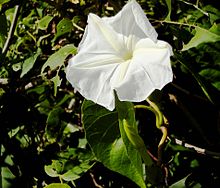Ipomoea violacea
| Ipomoea violacea | |
|---|---|

| |
| Scientific classification | |
| Kingdom: | Plantae |
| Clade: | Tracheophytes |
| Clade: | Angiosperms |
| Clade: | Eudicots |
| Clade: | Asterids |
| Order: | Solanales |
| Family: | Convolvulaceae |
| Genus: | Ipomoea |
| Species: | I. violacea
|
| Binomial name | |
| Ipomoea violacea | |
Ipomoea violacea is a perennial species of Ipomoea that occurs throughout the world with the exception of the European continent. It is most commonly called beach moonflower or sea moonflower as the flowers open at night.[1]
Description
The
corolla of the flower of Ipomoea violacea is white, distinguishing this species from Ipomoea tricolor, commonly called Heavenly Blue. It is sometimes mistaken for the cultivar
Pearly Gates, the corolla of which is also white, probably because of its
misleading Latin binomial name, Ipomoea violacea, "violacea" meaning purple.[2]
Comparative taxonomies
A comparison of the taxonomy of the two plants shows that they belong to different Subgenera, consequently, Ipomoea violacea should not be used as a synonym for Ipomoea tricolor. In exceptional cases where Ipomoea violacea has to be used as a synonym of Ipomoea tricolor, one must specify the incorrect usage by using the abbreviation 'Auct.' for Auctorum.[3]
Ipomoea violacea:[3]
- Genus: Ipomoea
- Subgenus: Eriospermum
- Section: Erpipomoea
Ipomoea tricolor:[4]
- Genus: Ipomoea
- Subgenus: Quamoclit
- Section: Tricolor
LSA presence
The
LSD[5][6] It is possible that some of these studies may have mistaken Ipomoea violacea for Ipomoea tricolor, e.g., works published in the scientific journal Phytochemistry[7] and quoted by the Sociedade Brasileira de Farmacognosia,[8] which purportedly showed the presence of Ergine
, also known as d-lysergic acid amide (LSA) in Ipomoea violacea.
The discoverer of
d-lysergic acid amide
. As of 2016, only Ipomoea tricolor is proved to contain LSA in its seeds.
References
Wikimedia Commons has media related to Ipomoea violacea.
Wikispecies has information related to Ipomoea violacea.
- ^ "Ipomoea violacea". Germplasm Resources Information Network. Agricultural Research Service, United States Department of Agriculture. Retrieved 18 December 2017.
- ^ "Herbarium musei parisiensis". Archived from the original on 2016-03-03. Retrieved 2012-09-01.
- ^ a b "Ipomoea violacea auct". Germplasm Resources Information Network. Agricultural Research Service, United States Department of Agriculture. Retrieved 18 December 2017.
- ^ "Ipomoea tricolor". Germplasm Resources Information Network. Agricultural Research Service, United States Department of Agriculture. Retrieved 18 December 2017.
- hdl:1811/22310.
- ISBN 0-412-01981-7p. 655.
- ^ Phytochemistry. Volume 57, Issue 5, July 2001, pp. 721–72.
- ISSN 0102-695X.
External links
- Dressler, S.; Schmidt, M. & Zizka, G. (2014). "Ipomoea violacea". African plants – a Photo Guide. Frankfurt/Main: Forschungsinstitut Senckenberg.
